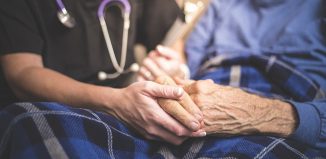CSHL’s Engel, Churchland team up for brain grant
By Daniel Dunaief
Movies have often used an image of a devil on one shoulder, offering advice, and an angel on another, suggesting a completely different course of action. People, however, weigh numerous factors when making even the simplest of decisions.
The process the brain uses to make decisions involves excitatory and inhibitory neurons, which are spread throughout the brain. Technology has made it possible to study thousands of these important cells on an active mouse, showing areas that are active at the same time.
Anne Churchland, an associate professor at Cold Spring Harbor Laboratory, and Tatiana Engel, an assistant professor at the same facility, are collaborating on a three-year grant from the National Institutes of Health that will study the way neurons interact to understand the patterns that lead to decisions.
Engel said she, Churchland and another collaborator on the project, Stanford University Professor Krishna Shenoy, applied for the funding in response to a call from the NIH to develop computational methods and models for analyzing large-scale neural activity recordings from the brain.
Churchland and Shenoy will provide experimental data for the computational models Engel’s lab will develop. The data is “huge and complex,” Engel said, and researchers need new methods to understand it. “The simple techniques don’t translate to large-scale recordings,” Engel said.
Churchland and Engel jointly hired James Roach, a postdoctoral researcher who recently earned his doctorate from the University of Michigan and works in both of their labs.
Churchland’s lab will provide data from the mouse model, while Engel’s lab brings computational expertise.
“Little is known about how these neurons are connected to behavior,” Engel said. Their research will hope to explain the role of inhibitory cells, which may have a more finely tuned function beyond keeping cells from remaining in an excited state.
The prevailing view in the field is that inhibitory neurons provide a balancing input to the network to prevent it from generating too much excitation or creating a seizure. Inhibitors are like the regulators that tap the brakes on a network that’s becoming too active.
Excitatory neurons, by contrast, are the ones that have an important job, representing the decisions individuals make.
Churchland is going to measure neural activity using a 2-photon microscope that allows her to measure the activity of about 600 neurons simultaneously.
“This provides an incredible opportunity to analyze the data, using tools borrowed from machine learning and dynamical systems,” she explained in an email.
What Churchland’s data has helped show, however, is that the inhibitory neurons are doing more than providing a global braking signal. “They have some dedicated role in the circuit and we don’t know what that role is yet,” Engel said.
The team will build neural circuit models to help understand how the system is wired and what role each type of cell plays in various behaviors.
“We are developing computational frameworks where we can go and analyze activities of large groups of cells and, from the data, determine how individual cells contribute to the activity of the population,” Engel said.
Brains have considerable plasticity, which means that when one area of the brain isn’t functioning for whatever reason — through an injury or a temporary blockage ‒ other areas can compensate. “The whole problem is immensely complicated to figure out what a brain area is doing normally,” she explained. The picture can “completely change when there’s brain damage.”
Research is moving in the direction of understanding and manipulating large neural circuits at once, rather than a single area at a time.
“Models can extract general principles, which still hold true even in more complex” systems Engel said. The principles include understanding how excitatory and inhibitory cells are balanced. “Models can help you figure out what works and doesn’t work.”
Roach, the current postdoctoral researcher working with Engel and Churchland, will start with modeling and then will develop experiments to test the role of inhibitory cells. He has already worked on computer programs that interpret neurological circuits and laboratory results. He is also receiving laboratory training.
At this point, Engel and Churchland are working on basic science. Engel explained that this type of research is the foundation for translation work that will lead to an improved diagnosis and treatment of neurological disorders. Basic science can, and often does, provide insights and information that help those working to understand or treat disease, she suggested.
Churchland was pleased with her collaboration with Engel.
Engel is “best known for modeling work she did studying neural mechanisms of attention,” Churchland explained in an email. “She is a great addition to Cold Spring Harbor! We work together in the same building and are trying to unravel the mysteries of how large groups of neurons in the brain work together to make decisions.”
A resident of the facilities at Cold Spring Harbor Laboratory, Engel grew up in Vologda, which is over 300 miles north of Moscow. Starting in seventh grade, she attended physics and math schools, first in her home town and then at a boarding school at the Moscow State University.
She learned to appreciate the value of science from the journals her parents subscribed to, including one for children called Kvant magazine. She solved physics problems in that magazine. “I enjoyed the articles and problems in Kvant,” she explained in an email.
As for her work, Engel suggested that there were many discoveries ahead. “It is an exciting and transformative time in neuroscience,” she said.







